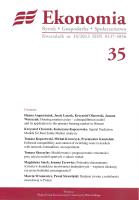Housing market cycles – a disequilibrium model and its application to the primary housing market in Warsaw
Housing market cycles – a disequilibrium model and its application to the primary housing market in Warsaw
Author(s): Hanna Augustyniak, Krzysztof Olszewski, Joanna Waszczuk, Jacek ŁaszekSubject(s): Economy, National Economy
Published by: Uniwersytet Warszawski - Wydział Nauk Ekonomicznych
Keywords: cycles in the housing market; disequilibrium; imbalances; banking sector; banking regulations
Summary/Abstract: This paper presents a simple disequilibrium model in the primary housing market, calibrated to the Warsaw market. Our aim is to point out that the primary housing market, due to the long construction process is always in disequilibrium, which has important policy implications. We discuss the last housing cycle and show how a combination of slight demand shocks with short-term rigid supply leads to strong fluctuations of house prices and new construction. The primary market can create a significant distress to the economy, because when house prices rise, this sector attracts capital and workers and is able to generate excessive supply, which finally can lead to the burst of the price bubble. The cyclical character is a permanent feature of the property market and can be explained by the inelasticity of supply. Market participants form price and demand expectations based on past observations. This causes frequent cycles that, under specific conditions, can lead to economic crises. We believe that the model describes the reality of the primary housing market better than equilibrium models do, so it can be useful for central banks and financial supervision institutions in the analysis of the impact of fiscal and monetary policy and regulations on the real estate market.
Journal: Ekonomia. Rynek, Gospodarka, Społeczeństwo
- Issue Year: 2013
- Issue No: 35
- Page Range: 5-23
- Page Count: 19
- Language: English

